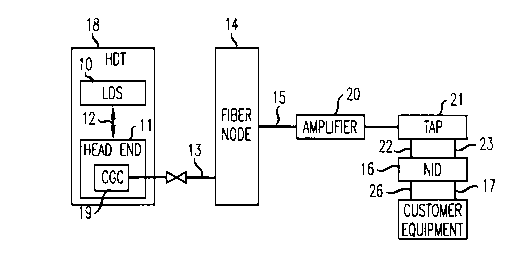Some of the information on this Web page has been provided by external sources. The Government of Canada is not responsible for the accuracy, reliability or currency of the information supplied by external sources. Users wishing to rely upon this information should consult directly with the source of the information. Content provided by external sources is not subject to official languages, privacy and accessibility requirements.
Any discrepancies in the text and image of the Claims and Abstract are due to differing posting times. Text of the Claims and Abstract are posted:
| (12) Patent Application: | (11) CA 2208620 |
|---|---|
| (54) English Title: | TRANSMISSION OF D-CHANNELS IN TELECOMMUNICATIONS SYSTEMS |
| (54) French Title: | TRANSMISSION D'INFORMATIONS DANS LES CANAUX DES SYSTEMES DE TELECOMMUNICATION |
| Status: | Deemed Abandoned and Beyond the Period of Reinstatement - Pending Response to Notice of Disregarded Communication |
| (51) International Patent Classification (IPC): |
|
|---|---|
| (72) Inventors : |
|
| (73) Owners : |
|
| (71) Applicants : |
|
| (74) Agent: | KIRBY EADES GALE BAKER |
| (74) Associate agent: | |
| (45) Issued: | |
| (22) Filed Date: | 1997-06-23 |
| (41) Open to Public Inspection: | 1998-01-25 |
| Examination requested: | 1997-06-23 |
| Availability of licence: | N/A |
| Dedicated to the Public: | N/A |
| (25) Language of filing: | English |
| Patent Cooperation Treaty (PCT): | No |
|---|
| (30) Application Priority Data: | ||||||
|---|---|---|---|---|---|---|
|
The invention is a circuit for transmitting digital information which
avoids wasting bandwidth when one channel is transmitted at a slower rate than
another channel. A superframe is set up to include a plurality of multiplexed frames.
At least one of the bursts in each frame is shared by a plurality of customers so that
each customer can transmit a full payload once for each superframe.
L'invention est un circuit de transmission d'informations numériques sans gaspillage de la bande passante quand les informations sont transmises à un débit moins grand dans l'un des canaux. Une supertrame constituée d'une pluralité de trames multiplexées est créée. Au moins l'une des salves de chaque trame est utilisée par plusieurs clients, de sorte que chaque client peut transmettre une charge complète dans chaque supertrame.
Note: Claims are shown in the official language in which they were submitted.
Note: Descriptions are shown in the official language in which they were submitted.

2024-08-01:As part of the Next Generation Patents (NGP) transition, the Canadian Patents Database (CPD) now contains a more detailed Event History, which replicates the Event Log of our new back-office solution.
Please note that "Inactive:" events refers to events no longer in use in our new back-office solution.
For a clearer understanding of the status of the application/patent presented on this page, the site Disclaimer , as well as the definitions for Patent , Event History , Maintenance Fee and Payment History should be consulted.
| Description | Date |
|---|---|
| Inactive: IPC from PCS | 2022-09-10 |
| Inactive: First IPC from PCS | 2022-09-10 |
| Inactive: IPC from PCS | 2022-09-10 |
| Inactive: IPC from PCS | 2022-09-10 |
| Inactive: IPC expired | 2011-01-01 |
| Inactive: IPC from MCD | 2006-03-12 |
| Inactive: IPC from MCD | 2006-03-12 |
| Inactive: IPC from MCD | 2006-03-12 |
| Inactive: IPC from MCD | 2006-03-12 |
| Application Not Reinstated by Deadline | 2002-08-26 |
| Inactive: Dead - No reply to s.30(2) Rules requisition | 2002-08-26 |
| Deemed Abandoned - Failure to Respond to Maintenance Fee Notice | 2002-06-25 |
| Inactive: Abandoned - No reply to s.30(2) Rules requisition | 2001-08-27 |
| Inactive: S.30(2) Rules - Examiner requisition | 2001-04-25 |
| Application Published (Open to Public Inspection) | 1998-01-25 |
| Inactive: IPC assigned | 1997-09-25 |
| Classification Modified | 1997-09-25 |
| Inactive: First IPC assigned | 1997-09-25 |
| Inactive: Filing certificate - RFE (English) | 1997-09-05 |
| Filing Requirements Determined Compliant | 1997-09-05 |
| Letter Sent | 1997-09-05 |
| Application Received - Regular National | 1997-09-02 |
| Request for Examination Requirements Determined Compliant | 1997-06-23 |
| All Requirements for Examination Determined Compliant | 1997-06-23 |
| Abandonment Date | Reason | Reinstatement Date |
|---|---|---|
| 2002-06-25 |
The last payment was received on 2001-03-23
Note : If the full payment has not been received on or before the date indicated, a further fee may be required which may be one of the following
Please refer to the CIPO Patent Fees web page to see all current fee amounts.
| Fee Type | Anniversary Year | Due Date | Paid Date |
|---|---|---|---|
| Registration of a document | 1997-06-23 | ||
| Request for examination - standard | 1997-06-23 | ||
| Application fee - standard | 1997-06-23 | ||
| MF (application, 2nd anniv.) - standard | 02 | 1999-06-23 | 1999-03-30 |
| MF (application, 3rd anniv.) - standard | 03 | 2000-06-23 | 2000-03-29 |
| MF (application, 4th anniv.) - standard | 04 | 2001-06-25 | 2001-03-23 |
Note: Records showing the ownership history in alphabetical order.
| Current Owners on Record |
|---|
| LUCENT TECHNOLOGIES INC. |
| Past Owners on Record |
|---|
| DAVID BRUCE KAHN |
| JEFFREY ALLEN MASUCCI |
| MICHAEL PHILIP BOTTIGLIERI |
| STEPHEN JOSEPH BROLIN |